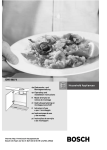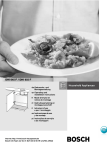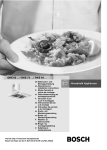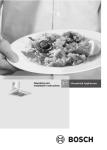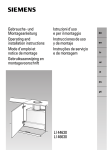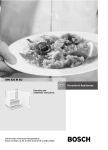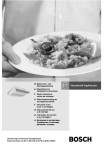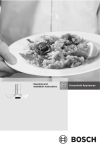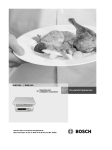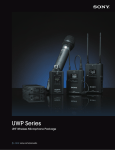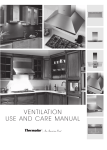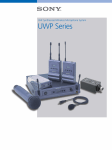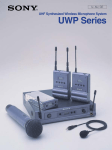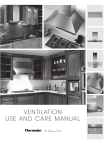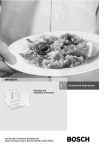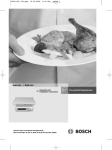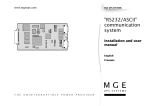Download Bosch DHI665VGB Operating instructions
Transcript
DHI 665 V / DHI 685 S
de Gebrauchs- und
Montageanleitung
en Operating and
installation instructions
fr Mode d’emploi et
notice de montage
nl Gebruiksaanwijzing en
montagevoorschrift
it Istruzioni d’uso
e per il montaggio
es Instrucciones de uso
y de montaje
pt Instruções de serviçio
e de montagem
Internet: http://www.bosch-hausgeraete.de
Bosch Info-Team: de Tel. 01 80/5 30 40 50 (E 0,12/Min. DTAG)
a
de
Seite
03 – 18
it
pagina
67 – 082
en
page
19 – 34
es
página
83 – 098
fr
page
35 – 50
pt
página
99 – 114
nl
pagina
51 – 66
Abb. 1
GAS
GAZ
KAASU
GASS
2
ELEKTRO
ELECTR.
ELETT.
EL.
Operating instructions:
Description of appliance
Light / fan switches
Filter drawer
Operating modes
Exhaust-air mode:
❑ The extractor-hood fan extracts the
kitchen vapours and conveys them
through the grease filter into the
atmosphere.
❑ The grease filter absorbs the solid
particles in the kitchen vapours.
❑ The kitchen is kept almost free of grease
and odours.
D If the extractor hood is operated in
exhaust-air mode at the same time as a
flue-type heater (e.g. gas, oil or solid-fuel
heater, instantaneous water heater, boiler),
ensure that there is an adequate air
supply which the heater requires for
combustion.
Safe operation is possible provided that the
partial vacuum in the room in which the
heater is installed does not exceed 4 Pa
(0.04 mbar).
Operating modes
This can be achieved if the combustion air
is able to flow through non-lockable
openings, e.g. in doors, windows and in
conjunction with an air supply/air-intake wall
box or by other technical procedures such
as reciprocal interlocking.
If the air intake is inadequate, there is a
risk of poisoning from combustion gases
which are drawn back into the room.
An air-intake/exhaust-air wall box by itself is
no guarantee that the limiting value will not
be exceeded.
Note: When assessing the overall
requirement, the combined ventilation
system for the entire household must be
taken into consideration. This rule does not
apply to the use of cooking appliances,
such as hobs and ovens.
Unrestricted operation is possible if the
extractor hood is used in recirculating mode
– with activated carbon filter.
Circulating-air mode:
❑ An activated carbon filter must be fitted
for this operating mode (see Filters and
maintenance).
! The complete installation set and
replacement filters can be obtained from
specialist outlets.
The corresponding accessory numbers
can be found at the end of these
operating instructions.
❑ The extractor-hood fan extracts the
kitchen vapours which are purified in the
grease filter and activated carbon filter
and then conveyed back into the
kitchen.
❑ The grease filter absorbs the grease
particles in the kitchen vapours.
❑ The activated carbon filter binds the
odorous substances.
!
If no activated carbon filter is installed,
it is not possible to bind the odorous
substances in the cooking vapours.
19
Before using for the first time
Important notes:
❑ The Instructions for Use apply to several
versions of this appliance. Accordingly,
you may find descriptions of individual
features that do not apply to your
specific appliance.
❑ This extractor hood complies with all
relevant safety regulations.
Repairs should be carried out by
qualified technicians only.
Improper repairs may put the user at
considerable risk.
❑ Before using your appliance for the first
time, please read these Instructions for
Use carefully. They contain important
information concerning your personal
safety as well as on use and care of the
appliance.
❑ Please retain the operating and
installation instructions for a subsequent
owner.
! Do not use the appliance if damaged.
! The appliance is not intended for use
! Do not flambé food directly under the
by young children or infirmed persons
without supervision.
Young children should be supervised to
ensure they do not play with the appliance.
! If the connecting cable for this
appliance is damaged, the cable must be
replaced by the manufacturer or his
customer service or a similarly qualified
person in order to prevent serious injury to
the user.
!
The appliance may be connected to
the mains by a qualified technician only.
!
Dispose of packaging materials
properly (see Installation instructions).
!
Light bulbs must always be fitted when
the extractor hood is in use.
!
Defective bulbs should be replaced
immediately to prevent the remaining bulbs
from overloading.
!
Never operate the extractor hood
without a grease filter.
!
Overheated fat or oil can easily catch
fire.
If you are cooking with fat or oil, e.g. chips,
etc., never leave the cooker unattended.
20
extractor hood.
Risk of grease filter catching fire due
to flames.
!
!
Restrictions apply to the use of the
extractor hood over a solid-fuel burner
(coal, wood, etc.). (See Installation
instructions).
Gas hobs / gas cookers
!
Always use gas hobs in a proper and
safe manner.
Important:
The flames from the gas hob must always
be covered by pots or pans.
The intense heat generated by the gas
flames could cause damage to the
extractor hood.
!
Operating the extractor hood
!
The most effective method of removing
vapours produced during cooking is to:
❑ Switch the ventilator ON
as soon as you begin cooking.
❑ Switch the ventilator OFF
a few minutes after you have finished
cooking.
❑ The fans in this appliance can be switched to the desired setting by hand
(manual mode) or can be controlled fully
automatically with the automatic function
according to your
requirements (automatic mode).
Switching on manual mode:
Press the L or + button.
❑ The fan starts at Setting }.
Appliances without automatic mode:
Fan – off –
Fan settings
– lower –
Fan – on –
Fan settings
– higher –
Switching on the fan settings/intensive
setting:
1. To increase the fan settings or switch on
the intensive setting ç, press the +
button.
❑ The intensive setting operates at
maximum power which should be
used only briefly.
If the intensive setting is not switched
off manually, the fan automatically
switches back to Setting } after
10 minutes.
2. To switch off the intensive setting ç or
switch back to fan settings ~ – } – | and
switch off the extractor hood
completely, press the – button.
Appliances with automatic mode:
(Ultraschall-Sensor)
Fan – off –
Fan settings – lower –
Fan – on –
Fan settings – higher –
Light
on / off
Intermittent
ventilation
Fan
on / off
Display:
❑ Fan settings / Intensive
setting
❑ Saturation –
grease filter #
❑ Saturation –
activated carbon filterr ã
Light
on / off
Fan
on / off
Automatic mode
/ Manual mode
Intermittent
ventilation
Display:
❑ Fan settings / Intensive
setting
❑ Saturation –
grease filter #
❑ Saturation –
activated carbon filterr ã
Switching over to automatic mode:
❑ To switch from manual mode to
automatic mode at any time, press the Ü
button.
21
Operating the extractor hood
Switching on automatic mode:
Intermittent ventilation
Press the Ü button.
❑ The fan runs at least at Setting |.
❑ Used for ventilating the kitchen at hourly
intervals at the lowest fan setting, round
the clock.
Switching on appliance:
Press the
button and insert the filter
drawer.
Fan settings:
❑ If required, the optimum fan setting is
actuated automatically via a sensor.
❑ The automatic function operates at
Settings | – ~.
Intensive setting:
1. To switch on the intensive setting ç,
press the + button.
❑ Automatic mode has been switched
off.
❑ The intensive setting operates at
maximum power which should be
used only briefly.
If the intensive setting is not switched
off manually, the fan automatically
switches back to the optimum fan
setting after 10 minutes.
2. To switch off the intensive setting, press
the – button.
❑ Automatic mode has been switched
on again.
Switching over to manual mode:
❑ To switch from automatic mode to
manual mode at any time, press the Ü
button.
22
❑ The fan runs for 5 minutes at Setting |,
then switches off for 55 minutes. This
process is repeated every hour.
Switching off:
Press the
button.
Operating the extractor hood
Switching off:
Special functions
There are 2 different methods of switching
off the appliance whether in manual or
automatic mode.
Switching off directly:
Press the L button.
Switching on the light automatically, e.g.
via a timer:
❑ Fan and light must be switched off.
Switching on:
Simultaneously press the a and L
buttons.
Important: All fan functions are switched
off.
Switching off appliance with fan run-on:
Insert filter drawer all the way. The fans
operate in the last switched-on stage for
around another 10 minutes and then switch
off.
❑ If the intensive setting is switched on
when the filter drawer is inserted, the
intensive setting automatically switches
back during run-on.
❑ If intermittent ventilation is switched on, it
continues operating normally following
run-on.
Light
❑ The light can be used at any time, even
when the appliance has been switched
off.
❑ After approx. 3 seconds the light
switches on to acknowledge the setting.
Switching off:
Repeat the process with the light switched
on.
❑ After approx. 3 seconds the light
switches off to acknowledge the setting.
Adjusting the sensitivity of the sensor
control:
1. Press and hold down the automatic
button.
2. To display the current sensitivity, press
the + or – button.
3. You can now change the sensitivity of
the sensor control by pressing the + or
– button.
Switching on/off: Press the a button.
Adjusting the brightness:
❑ Hold down the a button until the
desired brightness is obtained.
@.
{.
❑ Highest setting: Ö.
❑ Factory setting:
❑ Lowest setting:
23
Filters and maintenance
Grease filters:
Metal-mesh filters are used to trap the
grease particles in the cooking vapours.
The filter mats are made from noncombustible metal.
Caution:
As the filter becomes more and more saturated with grease, there is an increased risk
of fire and the function of the extractor
hood may be impaired.
Important:
By cleaning the metal grease filters at
appropriate intervals, the possibility of them
catching fire as a result of a build-up of heat
such as occurs when deep-fat frying or
roasting is taking place, is reduced.
Saturation indicator:
When the grease filters reach saturation
point, an acoustic signal is sounded for 6
seconds after the fan has switched off, and
an # appears in the display. The grease
filters should be cleaned straight away.
Removing and inserting the metal-mesh
grease filters:
Warning: The halogen bulbs must be
switched off and cool.
1. Pull the filter drawer all the way out.
2. Depress both catches at the front of the
grease filter and remove the grease filter.
3. Depress the catches at the rear of the
grease filter and remove the grease filter.
Cleaning the metal-mesh grease filters:
❑ The filters can be cleaned in a
dishwasher. However, they may become
slightly discoloured.
Important:
Do not wash highly saturated metalmesh grease filters with other utensils.
❑ If cleaning the filters by hand, soak them in
a hot soap solution. Then brush the filters,
rinse thoroughly and leave to drain.
4. Clean the filters.
5. Insert the clean filters back into the hood.
6. Cancel the # display.
❑ Press the L button for at least
3 seconds.
The # display then goes out.
24
Filters and maintenance
Activated carbon filter:
For neutralizing odours in recirculating
mode.
Caution:
As the filter becomes more and more
saturated with grease, there is an increased
risk of fire and the function of the extractor
hood may be impaired.
Important:
Change the activated carbon filter promptly
to prevent the risk of fire from the
accumulation of heat when deep-fat frying
or roasting.
Inserting the filter:
Warning: The halogen bulbs must be
switched off and cool.
1. Remove the metal filters
(see "Removing and inserting the metal
grease filters").
2. Insert the activated carbon filter.
3. Engage the catches at both sides.
4. Insert the metal-mesh grease filters (see
”Removing and inserting the metal-mesh
grease filters”).
5. Cancel the ã display.
❑ Press the L button for at least
3 seconds.
The ãdisplay then goes out.
Saturation indicator:
When the activated carbon filter is saturated, an acoustic signal is emitted for 6
seconds when the fan has switched off and
ã is displayed. The activated carbon filter
should then be replaced immediately.
Removing the filter:
Warning: The halogen bulbs must be
switched off and cool.
1. Remove the metal-mesh filters.
2. Depress the catches on both sides of
the filter and remove the activated
carbon filter.
3. Replacing the activated carbon filter:
❑ A replacement filter can be obtained
from any authorized dealer
(see optional accessories).
❑ Use original filters only.
This will ensure maximum
performance.
4. Insert the grease filters.
Disposing of the old activated carbon
filter:
❑ Activated carbon filters do not contain
any pollutants and can be disposed of
with domestic refuse.
25
Cleaning and care
Replacing the light bulbs
Isolate the extractor hood by pulling out
the mains plug or switching off the fuse.
❑ When cleaning the grease filters, remove
grease deposits from accessible parts of
the housing. This prevents the risk of fire
and ensures that the extractor hood
continues operating at maximum
efficiency.
❑ Clean the extractor hood with a hot soap
solution or a mild window cleaner.
❑ Do not scrape off dried-on dirt but wipe
off with a damp cloth.
❑ Do not use scouring agents or abrasive
sponges.
❑ Note: Do not use alcohol (spirit) on
plastic surfaces, as dull marks may
appear.
Caution: Ensure that the kitchen is adequately ventilated. Avoid naked flames!
1. Switch off the extractor hood and pull
out the mains plug or switch off the
electricity supply at the fuse box.
! Clean the operating buttons with a mild
soapy solution and a soft, damp cloth only.
Do not use stainless-steel cleaner to clean
the operating buttons.
! When switched on, the halogen bulbs
become very hot. Even for some time after
the bulbs have been switched off there is
still a risk of burns.
2. Remove the bulb ring with a screwdriver
or similar tool.
3. Replace the halogen light bulb
(conventional halogen bulb, 12 Volt,
max. 20 Watt, G4 bulbholder).
Caution: Plug-in bulbholder.
Take hold of the bulb with a clean cloth.
Stainless steel surfaces:
❑ Use a mild non-abrasive stainless steel
cleaner.
❑ Clean the surface in the same direction
as it has been ground and polished.
! Do not use any of the following to clean
stainless steel surfaces: abrasive sponges,
cleaning agents containing sand, soda, acid
or chloride!
Aluminium and plastic surfaces:
❑ Use a soft, non-linting window cloth or
micro-fibre cloth.
❑ Do not use dry cloths.
❑ Use a mild window cleaning agent.
❑ Do not use aggressive, acidic or caustic
cleaners.
❑ Do not use abrasive agents.
26
4. Re-insert the bulb ring.
5. Restore the power by inserting the mains
plug or switching on the fuse.
Note: If the light does not function, check
that the bulbs have been inserted correctly.
Moving the operating unit
Setting the saturation indicator
You can move the operating unit from
the middle of the filter drawer to the left
or right side.
The operating unit can also be fitted at the
front in a handle moulding available as an
optional accessory or in the enclosed
handle moulding (see optional accessories
on back page).
If the operating mode is to be switched
over (exhaust air/circulating air mode), the
saturation indicator for the filters must also
be switched over (see Installation
instructions).
Faults
1. Loosen the 2 screws from below.
2. Remove the operating unit and disconnect the plug from the ribbon cable.
3. Remove the side cover from the filter
drawer.
4. Connect the plug of the side ribbon
cable to the operating unit.
5. Insert the operating unit into the side of
the filter drawer.
! Insert the excess ribbon cable.
If # or ã is displayed:
❑ See "Filters and maintenance" Section.
If the extractor hood cannot be
operated:
❑ Isolate the extractor hood for approx.
1 minute by pulling out the mains plug or
switching off the fuse.
Then switch on again..
If you have any questions or if a fault
occurs, please call Customer Service.
(See list of Customer Service
representatives).
When you call, please quote the following:
E-Nr.
FD
Enter the numbers in the above box. The
numbers can be found on the rating plate
inside the extractor hood following removal
of the grease filters.
6. Insert the cover into the middle of the
filter drawer and screw on the cover from
below with 2 screws.
27
Installation Instructions:
Important information
! Old appliances are not worthless
rubbish. Valuable raw materials can be
reclaimed by recycling old appliances.
Before disposing of your old appliance,
render it unusable.
! You received your new appliance in a
protective shipping carton. All packaging
materials are environmentally friendly and
recyclable. Please contribute to a better
environment by disposing of packaging
materials in an environmentally-friendly
manner.
Please ask your dealer or inquire at your
local authority about current means of
disposal.
! The extractor hood can be used in
exhaust air or circulating air mode.
! Always mount the extractor hood over
the centre of the hob.
! Minimum distance between electric
hob and bottom edge of extractor hood:
430 mm, Fig. 1.
Additional information concerning gas
cookers:
! When installing gas hotplates, comply
with the relevant national statutory
regulations (e.g. in Germany: Technische
Regeln Gasinstallation TRGI).
! Always comply with the currently valid
regulations and installation instructions
supplied by the gas appliance
manufacturer.
! Only one side of the extractor hood
may be installed next to a high-sided unit
or high wall. Gap at least 300 mm.
28
! The installation of the extractor hood
above gas cooking devices, at a
minimum height of 650 mm (or 700 mm
with automatic cooker hoods) – Fig. 1 – is
permitted provided that the following
nominal heat loads (Hs) are not exceeded:
❑ Gas cookers
Load of one hotplate
max. 03.0 kW
Load of all hotplates
max. 08.3 kW
Load of the oven
max. 03.9 kW
❑ Gas hobs
Load of one hotplate
max. 03.9 kW
Load of all hotplates
max. 11.3 kW
❑ Gas ceramic hotplate
The nominal heat load specifications do
not apply to closed gas ceramic hobs.
Always observe the specifications of the
hob manufacturer.
❑ Solid-fuel cookers
The maximum nominal heat loads and
the minimum distance are the same as
for gas cookers.
!The extractor hood must not be
installed over a solid fuel cooker – a
potential fire hazard (e.g. flying sparks) –
unless the cooker features a closed,
non-removable cover and all national
regulations are observed.
! The smaller the gap between the
extractor hood and hotplates, the greater
the likelihood that droplets will form on the
underside of the extractor hood.
Prior to installation
Exhaust-air mode
The exhaust air is discharged upwards
through a ventilation shaft or directly
through the outside wall into the open.
D Exhaust air must not be discharged via
a smoke or exhaust gas flue which is
already in use or via a shaft which is used
for ventilating rooms in which fireplaces are
located.
Discharge exhaust air in accordance
with official and statutory regulations
(e.g. national building regulations).
Discharge of air into smoke or exhaust air
flues which are not in use requires the
consent of a heating engineer.
D If the extractor hood is operated in
exhaust-air mode at the same time as a
flue-type heater (e.g. gas, oil or solid-fuel
heater, instantaneous water heater, boiler),
ensure that there is an adequate air
supply which the heater requires for
combustion.
Safe operation is possible provided that the
partial vacuum in the room in which the
heater is installed does not exceed 4 Pa
(0.04 mbar).
This can be achieved if the combustion air
is able to flow through non-lockable
openings, e.g. in doors, windows and in
conjunction with an air supply/air-intake wall
box or by other technical procedures such
as reciprocal interlocking.
If the air intake is inadequate, there is a
risk of poisoning from combustion gases
which are drawn back into the room.
An air-intake/exhaust-air wall box by itself is
no guarantee that the limiting value will not
be exceeded.
Note: When assessing the overall
requirement, the combined ventilation
system for the entire household must be
taken into consideration. This rule does not
apply to the use of cooking appliances,
such as hobs and gas cookers.
The extractor hood can be used without
restriction in circulating air mode – with an
activated carbon filter.
For exhaust air mode a one-way flap
should be installed in the extractor hood
unless already installed in the exhaust air
pipe or wall box.
If a one-way flap is not enclosed with the
extractor hood, you purchase one from
your dealer.
If the exhaust air is conveyed through
the outside wall, a telescopic wall box
should be used.
29
Before installation
Optimum efficiency of the extractor
hood:
❑ Short, smooth exhaust pipe.
❑ As few bends as possible.
❑ Pipe diameter as large as possible
(ideally 150 mm dia.) and wide pipe
bends.
If long, rough exhaust-air pipes,
many pipe bends or smaller pipe
diameters are used, the air extraction
rate will no longer be at an optimum
level and there will be an increase in
noise.
❑ Round pipes
Short exhaust air pipe:
inside diameter min. 120 mm,
Longer exhaust air pipe:
inside diameter min. 150 mm.
❑ Flat ducts must have an inside
cross-section equivalent to that of the
round pipes.
There should be no sharp bends.
l 120 mm dia. approx. 113 cm2
l 150 mm dia. approx. 177 cm2
❑ If pipe diameters differ, insert sealing
strip.
❑ Ensure that there is an adequate air
supply for exhaust air mode.
Exhaust air directed backwards:
Only possible inside tall wall cupboards
depending on the size of the exhaust air
pipe.
❑ Make a hole in the rear panel of the wall
cupboard, cutting out a notch for the
power supply cable.
Exhaust air directed upwards:
0-**1-,"
#$%&'
(+,
()*
-)
.
#$%&
/*.
"
(,
!""
1. Make a hole in the top of the wall cupboard, cutting out a notch for the power
supply cable.
– template O
I enclosed –.
2. If fitted, cut out the cupboard base to a
min. depth of 270 mm over the entire
width.
Connecting a 150 mm exhaust pipe:
❑ Attach the exhaust pipe directly to the air
connector.
Connection of 120 mm l exhaust air
pipe:
❑ Attach enclosed reducing connector to
the air outlet.
Holes in the air outlet must be sealed.
❑ Attach exhaust air pipe to the reducing
connector.
Circulating-air mode
❑ With activated carbon filter if exhaust-air
mode is not possible.
! The complete
installation set can
be obtained from
specialist outlets.
The corresponding
accessory numbers
can be found at the
end of these operating instructions.
30
*-*
Preparing the wall cupboard
This extractor hood is designed to be
installed in a wall cupboard with the following dimensions:
width: 600 mm
depth: 293 to 350 mm
height: min. 435 mm.
If the cupboard is deeper than 293 mm,
the extractor hood can be moved back,
e.g. to put a spice rack in front of the
extractor hood.
II further
To do this, place the template O
back.
1. Mark two attachment points on both the
right and left inside faces of the cupboard and make holes with a bradawl.
! Ensure that the cupboard is stable both
during and after installation, even if fitted at
the end of a row of kitchen units.
When you drill:
2 mm diameter – max. 10 mm in depth.
II to mark
Use the enclosed template O
the attachment points.
2. Screw on both attachment plates.
3. Attach the door to the cupboard and
align.
! Observe the minimum distance
between hotplates and extractor hood!
Fig. 1.
Switching over from exhaust air to circulating air mode
Switching the electronic control system
to circulating air mode:
❑ The extractor hood has been set to
exhaust air mode at the factory.
❑ Before the mode can be changed, the
extractor hood must have been
connected and should be switched off.
1. Press and hold down the L button.
2. Press the
button for approx.
3 seconds.
❑ A ã is displayed.
3. Release the buttons.
❑ The display goes out shortly
afterwards.
Resetting to exhaust-air mode:
1. Repeat the procedure.
❑ A # is displayed.
2. Release the buttons.
❑ The display goes out shortly
afterwards.
31
Fitting into wall cupboard
!
Check door alignment and readjust if
necessary.
1. Remove grease filter
(see Operating instructions).
2. Lift the extractor hood into the cupboard
from below until both fixing lugs have
locked firmly into position.
4. If required, shorten the wall cover to the
required dimension (e.g. saw off).
Attach the wall cover with the enclosed
clips.
Screw the wall cover to the wall
cupboard.
3. Tighten the two fixing screws with a
screwdriver (cordless).
5. Feed the mains connection cable out of
the cupboard.
6. Connect the pipes in the wall cupboard.
– If required, attach the air hose to the
cupboard ceiling –.
7. Re-insert grease filter
(see Operating instructions).
Note: The extractor hood housing can be
clad inside the wall cupboard (e.g. with
chipboard).
If so, observe the following:
❑ The intermediate base must not be
placed on the extractor hood housing.
❑ Never attach cladding to the housing.
❑ Provide access for customer service.
❑ Align the extractor hood in the
cupboard.
❑ Carefully tighten both fastening screws.
! Check that the extractor hood is
secure in the cupboard.
32
Fitting into wall cupboard
❑ If the extractor hood is to be installed
further back in the cupboard, the stops
for the filter drawer can be moved
forwards.
❑ To do this, undo the screws, move the
stops and retighten the screws.
Moving the operating unit:
See Operating instructions.
Attaching the handle moulding:
A handle moulding must be attached to
the filter drawer.
This handle moulding may be a wooden
strip which matches the kitchen units or a
handle moulding available as an optional
accessory (see optional accessories on the
back page).
1. Using the enclosed template O
III , mark
the attachment points on the wooden
strip and make holes with a bradawl.
When you drill:
2 mm dia – max. 10 mm in depth.
Weight in kg:
Exhaust air
Circulating air
13,0
13,5
We reserve the right to construction changes within the
context of technical development.
2. Align handle moulding and screw to the
appliance.
! Do not pinch the ribbon cable.
33
Electrical connection
WARNING: THIS APPLIANCE MUST BE
EARTHED
IMPORTANT: Fitting a Different Plug:
The wires in the power cord are colourcoded as follows:
Green and Yellow
– Earth
Blue
– Neutral
Brown
– Live
If you fit your own plug, the colours of
these wires may not correspond with the
identifying marks on the plug terminals.
Proceed as follows:
1. Connect the green and yellow (Earth)
wire to the terminal in the plug marked
‘E’ or with the symbol (
), or
coloured green or green and yellow.
2. Connect the blue (Neutral) wire to the
terminal in the plug marked ‘N’ or
coloured black.
3. Connect the brown (Live) wire to the
terminal marked ‘L’, or coloured red.
The extractor hood may be connected to
a correctly installed earthed socket only.
Attach the earthed socket near the
extractor hood in an accessible position.
❑ The earthed socket should be
connected via its own power circuit.
If permanent connection is required:
The extractor hood may only be connected
by an electrician registered with the local
electricity board.
A disconnecting device must be provided
on the installation side. Switches with a
contact opening of more than 3 mm and
all-pole disconnection are regarded as
disconnecting devices. These include LS
switches and contactors.
This extractor hood complies with EU
regulations on interference suppression.
Removal from the wall
cupboard
1.
2.
3.
4.
Disconnect from power.
Disconnect pipes.
Remove filters.
Undo right and left fixing screws until the
extractor hood cannot drop any further.
! If appliances do not feature the OFF
delay function, the indicator may start flashing when the extractor hood has been
switched off for several hours via a separate switch, even though the grease filters are
not yet saturated.
(See instructions for use, section on filter
and maintenance).
Electrical specifications:
These can be found on the rating plate
inside the appliance following removal of
the filter frames.
! Before carrying out repairs, always
isolate the appliance.
Length of the connection cable: 1.30 m.
34
! Do not lift the extractor hood when
undoing the fixing screws.
5. Raise the extractor hood briefly until the
fixing lugs detach and the appliance can
be lowered.
! Fastening screws may project.
When raising the extractor hood, do not
force in the filter drawer.
6. Preparing for re-installation:
Screw in the left and right fixing screws
until the lugs are pressed out at the
sides.
2
1
3
DHZ 4505
4
5 3x
434229
Aluminium: DHZ 4675
Metall:
DHZ 4655
Aluminium: DHZ 4670
Metall:
DHZ 4650
Absenkrahmen
Lowering frame
Du cadre
d’abaissement
Befestigingsframe
Dei telai per
l’abbassamento
Bastidor para bajar
DHZ 4600
Robert Bosch Hausgeräte GmbH
5750 203 747
Printed in Germany
0704 Es.




















